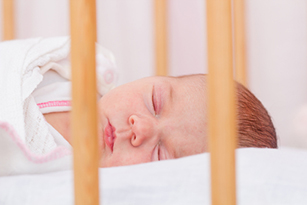 A controversial subject, co-sleeping (sharing a bed with your infant) may provide rest and convenience for breastfeeding and sleep-deprived moms, but it comes with serious risk of infant death caused by suffocation, asphyxia and entrapment.
A controversial subject, co-sleeping (sharing a bed with your infant) may provide rest and convenience for breastfeeding and sleep-deprived moms, but it comes with serious risk of infant death caused by suffocation, asphyxia and entrapment.
The American Academy of Pediatrics (AAP) published a strong position statement against co-sleeping recently, which provided detailed instruction on the best ways to keep your baby safe while sleeping.
AAP offers extensive data on pediatric deaths in bed with parents, as well as research on infant respiration to support its instructions, which are as follows:
- Infants should only sleep on their back, in a bassinet or crib that meets modern safety standards.
- Babies should be in a bare crib – no bumpers, pillows, blankets or quilts; mattresses should be firm and should maintain their shape, even when a fitted sheet is used.
- Infants should stay in their parents’ room until 6 months of age, then can be moved into a different room; room-sharing without bed-sharing provides close proximity, which facilitates feeding, comforting and baby monitoring.
In the United States, parent-infant bed-sharing is still common despite the known risks. In one national survey, 45 percent of parents said they had shared a bed with their infant (8 months of age or younger), according to AAP.
Then why do so many mothers (including Dr. B, who did so at times with her own babies) so often sidestep the established recommendations? And how do I, as a pediatrician who has done it myself, reconcile this conflict for parents in my own practice?
As a mother, I believe much of our motivation to co-sleep stems from pure exhaustion. We sleep-deprived moms realize quickly that babies emerging from 10 months in our womb are more peaceful if they are close to our bodies. And nursing is easier when your baby is at arm’s length, eliminating the need to sit up, get up or fully wake up.
Additionally, many breastfeeding advocates strongly endorse co-sleeping, muddying the waters as mothers seek expert opinions that support their own choices.
Our son, Jack, was exceptionally colicky. One of the few things that quieted him was sleeping next to me. One night, in a near comatose state caused by weeks of dealing with a fussy baby, I woke up in a panic because I had fallen so deeply asleep that I no longer knew where my baby was sleeping.
Knowing that I had slept so soundly and that I could easily have rolled onto him shocked me and provided enough fear that I realized he needed to sleep in his bassinet. It was a struggle, because he didn’t like the bassinet; it was cold, impersonal and isolating. But I learned a few tricks along the way, including preheating his bassinet with a heating pad, then removing it before putting him down. I was trying to imitate my body heat, and I think it helped. I also had the bassinet arranged next to the bed, so that my arm could lay next to his little body. Draped over the edge, my arm fell asleep right along with him. But I felt better knowing that he was in a safe environment. There are other tricks, as well, such as swaddling.
As a pediatrician, I often struggle advising new moms and dads. But the AAP recommendations could not be clearer. If I provide advice that is in direct opposition to the AAP, a family whose child dies in a co-sleeping situation can sue me. On the other hand, I run the risk of alienating parents if I press the issue.
I have chosen what I hope to be a wise middle ground. I tell everyone that AAP never recommends co-sleeping, and I explain all the reasons why. I also acknowledge the need for parents to sleep and their desire to breastfeed easily. And I often tell them my own story.
As in every aspect of parenting, I feel that my role as a pediatrician is to educate, to provide data when it’s available, to share my own experiences and, finally, to support the choices my patients’ families make.
